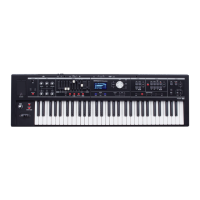23
This unit lets you use the top panel harmonic bars to modify the
character of the synthesizer sound.
MEMO
• If you’re playing two sounds (split or dual) (p. 28), the settings will
determine which sound is aected.
• If one of the sounds is an organ sound
The bars will operate as harmonic bars for the organ sound.
The synthesizer sound will not change.
• If one of the sounds is a piano sound
The piano sound cannot be changed. The eect will apply
only to the synthesizer sound.
• If two synthesizer sounds are combined
The bars will aect both synthesizer sounds.
• The eect can also be applied when playing a single piano sound.
• For some acoustic sounds (p. 53), DECAY, CUTOFF, and
RESONANCE will have no eect.
Changing the Volume Envelope
(ATTACK, DECAY, RELEASE)
The shape that describes how an instrument’s volume changes
over time from the beginning to the end of the note is called the
“envelope.”
On a keyboard instrument, this species the way in which the
volume changes from when you press a key until you release the key.
Volume
Note-on Note-o
Time
Sound Ends
A D
S
R
D: DECAY
S: SUSTAIN
R: RELEASE
Parameter Explanation
ATTACK
Time from when you press the key until the full
volume is reached
DECAY
Time over which the volume reaches the SUSTAIN
level following the attack
SUSTAIN
Volume at which the sound is sustained while you
continue holding the key
RELEASE
Time over which the sound decays to silence after
you release the key
On this unit you can use the three left-most harmonic bars to adjust
the ATTACK, DECAY, and RELEASE times of the currently selected
sound.
1. Select a sound from the synthesizer section (p. 14).
2. Move the bars to adjust the values of the corresponding
parameters.
Bar Value Explanation
[ATTACK] bar -64–63
Lowering the bar will shorten the attack
time; raising the bar will lengthen the
time.
[DECAY] bar -64–63
Lowering the bar will shorten the time
over which the level falls to the SUSTAIN
level; raising the bar will lengthen the
time.
[RELEASE] bar -64–63
Lowering the bar will shorten the time
over which the sound disappears; raising
the bar will lengthen the time.
When you operate a bar, the current value is shown in the screen.
MEMO
• While the value of a parameter is displayed, you can turn the
[VALUE] dial to adjust the value.
• The value of each parameter is shown as an oset relative to the
default value originally specied for each sound. At a value of “0”
(the bar near the center “4” position), that parameter will be in its
original state.
• If you press the [TRANSPOSE] button while the adjustment
screen is shown, the adjustment screen will be held. Press the
[EXIT] button to return to the previous screen.
Adjusting the Tonal Character (CUTOFF,
RESONANCE)
The lter determines the tonal character of the sound.
You can use the lter to cut or boost dierent frequency regions of
the sound, thus modifying its character.
Parameter Explanation
CUTOFF
Frequency at which the lter takes eect (cuto
frequency)
RESONANCE
Amount by which the region near the lter’s cuto
frequency is emphasized
On this unit you can use the two right-most harmonic bars to adjust
the cuto and resonance of the currently selected sound.
1. Select a sound from the synthesizer section (p. 14).
2. Move the bars to adjust the values of the corresponding
parameters.
Bar Value Explanation
[CUTOFF] bar -64–63
Species the cuto frequency. Lowering
the bar will make the sound darker (more
mellow); raising the bar will make the
sound brighter.
[RESONANCE]
bar
-64–63
Boosts the sound in the region of the
cuto frequency, producing a distinctive
tonal character. Lowering the bar will
weaken this character, and raising the bar
will strengthen it.
When you operate a bar, the current value is shown in the screen.
* Some settings may produce noise or high-volume sound. Be
careful of the volume of the connected mixer or amp.
MEMO
• While the value of a parameter is displayed, you can turn the
[VALUE] dial to adjust the value.
• The value of each parameter is shown as an oset relative to the
default value originally specied for each sound. At a value of “0”
(the bar near the center “4” position), that parameter will be in its
original state.
• If you press the [TRANSPOSE] button while the adjustment
screen is shown, the adjustment screen will be held. Press the
[EXIT] button to return to the previous screen.
Modifying the Synthesizer Sound
Introduction Performing Recording Looper Settings
Appendix

